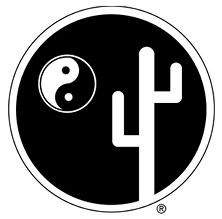"Be still as a mountain, move like a great river."
-- Wu Yu-hsiang

(The Chinese characters for T'ai Chi Ch'uan)
T’ai chi ch’uan is an extremely safe style of exercise that is also challenging.
Beginning as a Chinese martial art, it was discovered that the practice of it conferred great effects on ones health.
Originally shrouded in mystery (fathers only taught sons and the most trusted family members the secrets) until about 150 years ago, when Yang Lu Chan (known as Yang the invincible) first brought the art to the public.
The lineage of his students have included many great teachers in China, Taiwan, Malaysia, the United States, and many other countries.
If you are looking for an exercise that is very low-impact and research proven to improve balance, strength, endurance, bone density, flexibility, coordination, blood pressure, and improve your ability to handle stress physically and mentally, t’ai chi is the best exercise.
Not only these benefits, but you also learn a skill that can develop into a martial art too.
T’ai chi uses the ancient and still developing philosophy of being in harmony with nature to create this exercise system. This is the reason why its practice helps the health of the body and mind.
Practitioners of t’ai chi continually work on improving the art and its beneficial effects.
Once learned, t’ai chi can be practiced anywhere, no special equipment or clothing is required. Just 8-10 minutes per day of practice is beneficial.
For a good link to the health benefits of t'ai chi by the National Institute of Health: Tai Chi: An Introduction
Chang San-feng (12 century), the founder of T'ai Chi Ch'uan, said in creating t'ai chi that he “...desired for the whole world to attain longevity, not only martial techniques.” (from The Essence of T'ai Chi Ch'uan, Lo/Inn/Amacker/Foe translators.

Professor Cheng Man-Ching (Zheng Manqing)
Born about 1900 in the Zhejiang (Chekiang) province in mainlaind China, Cheng Man-Ching, the creator of the 37 Posture Simplified Yang Form, achieved great reknown as the "Master of Five Excellences". Trained originally as a painter, it was his mastery of that art which paved the way for a number of professorships at colleges in Shanghai when he was only in his early twenties. An avid learner with a photographic memory, his abilities grew in many skills until he achieved levels of mastery not only in painting, but also calligraphy, poetry, medicine, and the martial arts.
During his years teaching at the university in Shanghai, he contracted a severe case of tuberculosis. He was steered towards t'ai chi ch'uan as a potential cure, and so began to study under the Yang Form Master Yang Cheng Fu. His hard work at t'ai chi ch'uan eventually cured him of his tuberculosis, and when Master Yang's wife became seriously ill, he was able to return the favor to his master by writing prescriptions for his wife which are credited for curing her illness. It was shortly after this, that he was taken into the inner circles of Yang Cheng Fu's students and trained at the highest level.
When the war between Japan and China broke out in the 1930's, Cheng Man-Ching was appointed Professor of Martial Arts at one of the Chinese military academies. Due to his limited time, and the varying levels and abilities of his students, Professor Cheng attempted to simplify the Yang Form, which was well over 100 postures and took considerable time to learn. Boiling the Yang Form down to its most basic elements, Professor Cheng devised the 37 posture Yang Style Short Form, which allowed his students to learn t'ai chi ch'uan at a more accelerated rate. Professor Cheng's Short Form met the approval of Yang Cheng Fu's students, and became a very popular format for practicing the Yang Style Form.
Professor Cheng Man-Ching is credited as one of the first t'ai chi ch'uan instructors to teach in the United States. From the mid-60's until his passing in 1975, he not only taught t'ai chi ch'uan, but also practiced Chinese medicine most notably in New York and also during his trips back to Taiwan. It was in 1974 that he requested his "first" Taiwan student, Mr. Benjamin Lo, who had been studying with Professor Cheng since 1949, come to America to teach. Mr. Benjamin Lo has had an outstanding career as a teacher of t'ai chi ch'uan bringing the art to many students around the world through his camps and workshops, as well as his students in his American hometown of San Francisco. The Arizona T'ai Chi Ch'uan Association is directly descended from Mr. Benjamin Lo and associates with his direct students. We strive to humbly teach Professor Cheng Man-Ching's 37 posture Simplified Yang Style of t'ai chi ch'uan.
